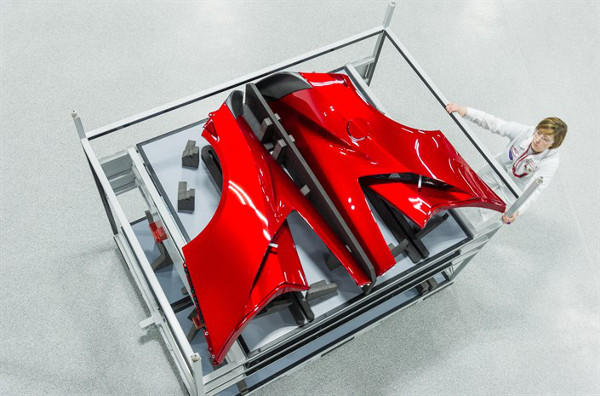Performance Manufacturing Centre is exclusive global production hub for Honda NSX
Series production due to commence in April 2016
World-class facility combines innovative technologies with next-generation craftsmanship
Honda’s new Performance Manufacturing Centre (PMC) in Marysville, Ohio will begin series production of the next-generation Honda NSX supercar in late April 2016. Deliveries for European customers are due to start in autumn 2016.
The Performance Manufacturing Centre is the exclusive newly-built global manufacturing facility for the all-new NSX. Conceived to innovate both the means and the methods of producing low-volume specialty vehicles, the PMC meets the challenges of combining next-generation craftsmanship and quality through fresh approaches to vehicle construction, paint, assembly and quality confirmat
The NSX is constructed entirely in-house at the PMC, which was a clean-sheet development designed around the NSX’s unique multi-material body and aluminium-intensive spaceframe.
“All of the innovative thinking and hard work that has gone into the creation of this state-of-the-art manufacturing facility has fulfilled our goal to build a supercar in America,” said Clement D’ Souza, the engineering large project leader of the PMC, who managed the creation of the facility. “The incredible passion and challenging spirit of our highly skilled associates is readily seen in the world-class quality and incredible dynamic performance of this next generation Honda NSX supercar.”
The PMC employs approximately 100 associates who support or are directly engaged in body construction, painting, assembly and quality confirmation. These craftspeople work together with advanced robotics to build the NSX to the highest levels of quality and craftsmanship.
The combination of human craftsmanship and technological innovation in the NSX manufacturing process has led to the application for 12 U.S. patents.
Precision robotic weld technology
The aluminium-intensive spaceframe is created with 100 percent robotic MIG welding, the first time this technique has been used in the automotive industry. Eight weld robots apply 860 MIG welds to the spaceframe, ensuring precise and repeatable welds, resulting in a highly accurate body assembly process. 360-degree-rotating rotisserie-style body fixtures aid precision by turning the body during the process to provide optimal access for the robotic weld arms.
Zirconium pre-treatment
The spaceframe undergoes an etching process prior to application of corrosion-resistant primer using a zirconium-based material. While instrumental for world-class quality, the use of zirconium also reduces environmental waste in the painting process.

Rotisserie-style sealer application
The use of two rotisseries in the body sealing application process – in which the spaceframe is loaded onto the mechanism, elevated and rotated 360 degrees – provides for more precise application of sealer and improved ergonomics for technicians. The rotisserie is also employed in an industry first application, in that it allows for one-sided attachment of the spaceframe for more efficient loading and unloading. The design is patent-pending.
Ablation casting
A first-ever application of new casting technology in the automotive industry, ablation casting is utilised for the creation of six nodes with the spaceframe, serving as rigid suspension and powertrain mounting points and as critical elements of the crash structure. The ablation cast nodes are produced at Honda’s Anna, Ohio engine plant, where the V6 engine is also assembled.
In-line quality confirmation
Highly skilled weld technicians visually inspect and accurately measure each part at every stage of the welding process. This practice validates the quality, precision and dimensional accuracy of the spaceframe, which is critical for both the dynamic performance of the vehicle and precise fitment of its powertrain, suspension, body panels and other components.
All-glass quality confirmation hub
A ‘total quality’ approach to the production process is evident not only in the mindset of every technician, but also in the design of the facility. The PMC features a glass-enclosed quality confirmation hub that is centrally located within the plant. This allows technicians from every department to monitor all aspects of a vehicle as it moves through each stage of the production process.
World-class craftsmanship
Throughout assembly, hand craftsmanship complements the advanced robotic processes. Manufacturing technicians spend over 14 hours assembling the powertrain, suspension, electronics, interior components and exterior body panels. Advanced visual operations standards aid technicians in ensuring that each process is performed to established requirements.
Every bolt is hand started by a technician and tightened to exact tolerances using wirelessly enabled torque wrenches. This technology allows for the recording of torque settings for every bolt on every car, further ensuring quality in the assembly process.
Unlike cars with a conventional unibody construction – where exterior panels are attached in welding – the NSX utilises a spaceframe design, which requires the exterior body panels to be the last parts fitted. This enables these exterior panels to be installed with high levels of precision, achieving superior quality of fitment.
World-class exterior finish
Along with extensive substrate preparation and polishing processes, each NSX has up to 11 coats of primer and paint applied, resulting in a high-quality surface finish unmatched in the class.
Dynamic performance confirmation
Drawing from Honda’s extensive competition expertise, the NSX undergoes a rigorous pre-delivery dynamic performance confirmation process. This rigorous regime includes a detailed 45-minute wheel alignment process, four-corner weight and ride height check and precision measurements of brake performance at all four wheels, along with other critical performance quality checks. Half of the 12 U.S. patent applications relate to the unique processes created in this area.
Twin-turbocharged V6 engine
The bespoke twin-turbocharged V6 engine with dry sump lubrication is meticulously hand assembled by a small group of master technicians at the company’s engine plant in nearby Anna, Ohio. Each engine takes over six hours to assemble by hand using techniques and processes benchmarked against the company’s world-class race engineering programmes to ensure the highest possible quality and performance standards are achieved. Every component is assembled by hand, for example, and each of the 547 bolts is manually tightened to precise torque tolerances.
Once fully assembled, each NSX engine is machine balanced, bench tested and run-in to the equivalent of 150 miles of service to ensure that every NSX is track-ready upon delivery to the owner.




